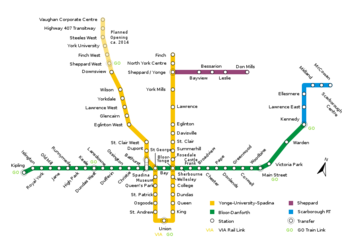Toronto Subway and RT
| Languages | English |
|---|
 | |||
| Info | |||
|---|---|---|---|
| Managed by | City of Toronto, Ontario, Canada | ||
| Locale | Toronto | ||
| Transit type | Rapid Transit | ||
| Number of lines | 4 | ||
| Number of stations | 69 | ||
| Daily ridership | 1,054,200 (per weekday 2011) | ||
| Chief executive | Dominique Lemay | ||
| Headquarters | 1900 Yonge Street, Toronto, Ontario | ||
| Operation | |||
| Began operation | March 30, 1954 | ||
| Operator(s) | Toronto Transit Commission(TTC) | ||
| Number of vehicles | 706 | ||
| Technical | |||
| System length | 70 km (43.00 mi) | ||
| Track gauge |
Subway: 4 ft 10 7⁄8 in RT: 4 ft 8 1⁄2 in | ||
| |||
The Toronto Subway and RT is a steel-wheeled subway system, and is the main form of transportation for the residents of Toronto, Ontario.
The Subway, Canada's first completed subway, opens on March 30th, 1954 with an original network of 12 stations. The TTC Subway is the largest in Canada and the second busiest behind the The Montreal Métro in terms of daily ridership. The Toronto Subway has 69 stations along 4 lines and 70 kilometers (43mi) of track, with 6 more stations planned North of Downsview Station on the Yonge-University-Spadina line.
History
Early Years
The first serious proposal for an underground network in Toronto was proposed in 1909 and again in 1912, both were voted against by the residents of Toronto. The next preposition was in 1931, a North-South line between Avenue Road and St-Clair Avenue, then south to Front and York streets, making a wide loop via Front, Scott, Victoria and Gerrard.
During World War II, workers travailing from the northern part of Toronto (Today part of the core) towards the industry sectors east and west of Downtown on Yonge were straining the creation of a subway line because of the worry of post-war boom in car ownership, would saturate the city in traffic.
The Toronto Transportation Commission formed a Rapid Transit comity in 1942 and proposed a streetcar network which would have both up-ground and underground tracks. The proposed plan was, underground from Eglinton Avenue to Front Street and a short distance from Front street to the Union Station Terminal. The plan was sent to vote on January 1st, 1946 and was accepted overwhelming by the residents.
The Toronto Transportation Commission announced that the 20% of the cost would be absorbed by the federal government. A disagreement occurred and the funding was cancelled, therefore forced the the TTC to cut the plan by 20%, which was again approved by the residents.
The 7.4 km stretch of subway was officially opened on March 30th, 1966 in the presence of Ontario Premier Leslie Frost and Toronto Mayor Allan A. Lamport. The trains ran at an average of 32km/h and trains were composed of 6 cars during peak periods and 4 cars during the off-peak. The plan originally called for a 4 car set during peak and 2 car set during the off-peak, but because of the instant success on the Yonge line it was abandoned.
1960 through 1980
Rail Fleet
| Thumbnail | Fleet number range | Year | Manufacturer | Model | Moter | Remarks |
|---|---|---|---|---|---|---|
| 3000 to 3023 | 1982-84 | UTDC | ICTS | |||
| 3024 to 3027 | 1986 | UTDC | ICTS | |||
| 5000 to 5371 | 1995-2001 | Bombardier | T1 | ADTranz 1507A | ||
| 5670 to 5807 | 1976-79 | Hawker Siddeley | H5 | Garrett 2000622-1 |
| |
| 5810 to 5935 | 1976-79 | UTDC | H6 | Brush Traction TMC 2072A |
| |
| 5381 to 6076 | 2010-13 | Bombardier | T35A08 | Bombardier MITRAC Three Phases AC |
|
Yards
| Rail yard | Location | Notes |
|---|---|---|
| Davisville | 1900 Yonge Street | Wilson's subyard |
| Greenwood | 400 Greenwood Avenue | |
| McCowan | 1720 Ellesmere Road | Greenwood's subyard |
| Wilson | 160 Transit Road |
| |||||||||||||||||
